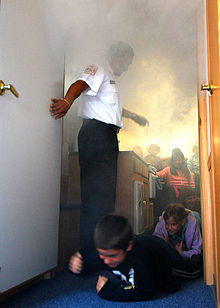- Crawling (human)
-
Babies usually learn to crawl before they develop walking skills. Crawls can refer to the specific gait or to any gait involving the arms and legs. Crawling is used mainly:
- When he/she cannot walk because of being an infant or due to disability or being wounded or sick.
- In very low places (caves, under a table, in a mine, etc.). Sometimes underground miners need to crawl long distances during their work.
- When searching for something on the ground.
- To get down to the ground in gardening, for maintenance or other work-related purposes which require a good reach on the ground
- For stealth (camouflage and quietness)
- To lower the field of vision
- As an exercise
- For fun or comical purposes.
Contents
Crawl
Crawling is a specific 4-beat gait involving the hands and knees. A typical crawl is left-hand, right-knee, right-hand, left-knee, or a hand, the diagonal knee, the other hand then its diagonal knee. This is the first gait most humans learn, and is really only practical during early childhood, or when looking for something on the floor or under low relief, though some often do so for personal pleasure. It can be used to move with a lower silhouette, but there are better crawls for that purpose. This is the most natural of the crawls and is the one that requires the least effort.
Bear crawl
The bear crawl is almost identical to the regular crawl, but the feet are used instead of the knees, which creates an arched or squatted body posture. This works as a faster crawl but requires more effort to maintain.
Crab crawl
The crab crawl is an upside down bear crawl. This is the most unnatural of the crawls, requiring the most effort, and is used in crab soccer. The crab crawl starts by sitting down with the feet and hands flat on the ground, the hips are then raised off the ground and the chest faces the sky. Due to its inefficiency, it is more commonly used as a form of exercise than actual transportation. Crabwalking builds triceps endurance[1] and arm and leg strength, and is a recommended exercise of various school athletic departments and soccer organizations (such as USA Football). Because of its unusual appearance, crabwalking has been used in several horror films to suggest the demonic possession of a character. These have included The Exorcist and The Unborn.
The crab crawl is also useful for descending steep slopes with poor traction. Its feet-first orientation ensures a low center of mass to prevent tumbling, while the inverted posture allows one to see where he or she is going.
Leopard crawl/High crawl
The leopard crawl is a military-specific crawl. There are two versions, the leopard crawl proper and a modified version for when carrying weapons in the hands. This is a two-beat gait like a trot: an arm/elbow is advanced with the diagonal knee. This is designed for the smallest silhouette possible, and the body is often nearly or actually touching the ground, and although the elbow and knee are the main focus, most of the respective limbs touch the ground.
Tiger crawl
The tiger crawl is essentially a highly accelerated combination between crawl and leopard crawl. It uses the hands and the knees/feet depending upon the situation, while maintaining a silhouette almost as small as that of the leopard crawl. This is relatively fast gait but can take large amounts of energy.
References
Categories:- Human skills
- Locomotion
Wikimedia Foundation. 2010.

